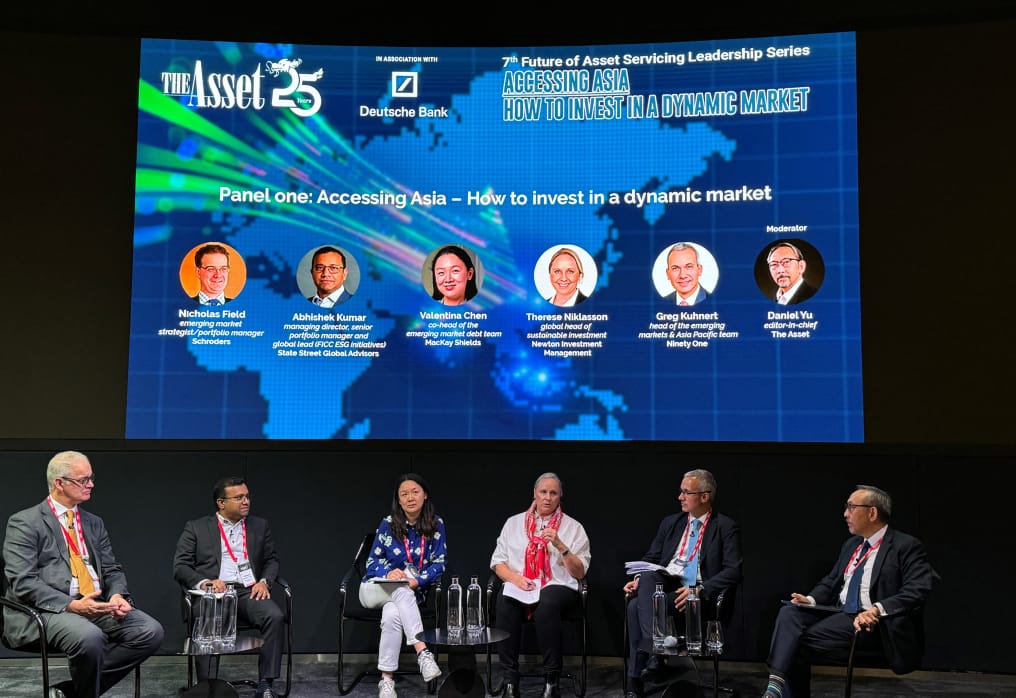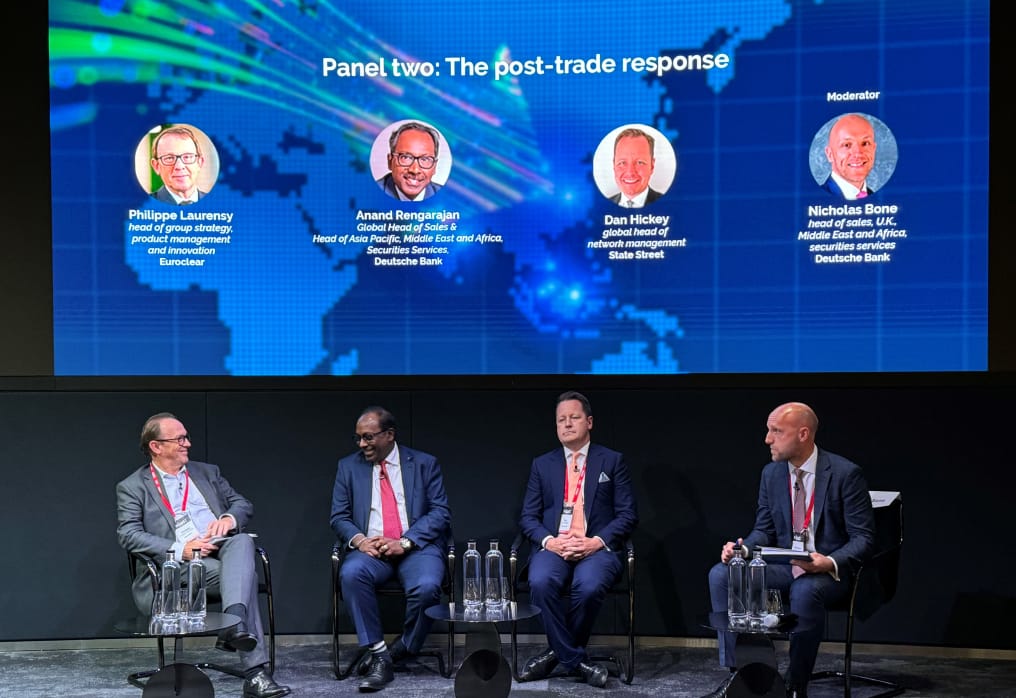16 October 2024
As Asia continues to attract attention for its high growth and promising returns, flow shares key takeaways and reflections from a seminar hosted by The Asset in association with Deutsche Bank on the Asia investment opportunity and the post-trade response
MINUTES min read
How can investors and providers of post-trade services steer the right course when it comes to navigating Asian’s dynamic investment markets? These questions were addressed at The Asset’s 7th Future of Asset Servicing Leadership series – Accessing Asia – how to invest in a dynamic market. Supported and hosted by Deutsche Bank at its new 21 Moorfields London auditorium, this article pulls together the main conclusions from the event’s two lively panel sessions.
“Buoyed by strong fundamentals, Asia’s financial markets are coming into their own. Its vast and interconnected markets are teeming with opportunities. And in a period where economic development is sluggish, Asia remains a key engine driving global growth,” reported The Asset in the event invitation.
Introduced by Anand Rengarajan, Deutsche Bank’s Head of Global Sales and Head of Asia Pacific, Middle East and Africa, Securities Services, it fell to Henry Allen, Macro Strategist at Deutsche Bank Research to set the macro backdrop – with an overall reflection that “the global outlook feels noticeably more positive than a year ago”.
“The biggest driver of where assets are going is macroeconomics"
“We do think the global economy is moving into a more stable equilibrium from here,” said Allen. “One thing that shows you just how things have transformed in the last 12 months is that a year ago, people thought the US would just grow at 1% but that has more than doubled”.
He continued, “After very high inflation – the highest for 40 years – it does potentially look like the central banks might be successful in bringing inflation back to target without a recession.” Allen and Daniel Yu, the Editor in Chief of The Asset who moderated the panel that followed, agreed that markets do not trade that much on geopolitics (unless a major war takes place in the country) and that “the biggest driver of where assets are going is macroeconomics”. Hence the attraction of Asia, with its favourable demographics, political reforms and strong manufacturing, technology and service exports.
For example, over the next decade, for example, the Association of Southeast Asian Nations (ASEAN) is forecast to grow by US$1.2trn, India is on track to become the world’s third-largest economy,1 and China is expected to leapfrog the US to become the world’s largest economy.2
China bounces back

Panellists left to right: Nicholas Field (Schroders); Abhishek Kumar (State Street Global Advisors); Valentina Chen (MacKay Shields); Therese Niklasson, (Newton Asset Management) Greg Kuhnert (Ninety-One); and Daniel Yu (The Asset and Moderator)
After a period of significant growth, in recent years the combination of an ongoing property crisis, increasing debt, and continued weak consumption has slowed down investment into China in recent years as investors increasingly seek opportunities elsewhere in the ASEAN region. But China has been showing signs of bouncing back, noted panellists on ‘Accessing Asia – how to invest in a dynamic market’ (pictured).
Investor appetite for the world’s second largest economy is slowly returning. In May 2024, for example, the IMF raised its economic growth forecast for China by 0.4 percentage points to 5%.3 Such is the strength of China’s trajectory, that even if growth slowed to 3%, China's GDP in 2030 would still be approximately US$5trn higher than in 2022.4
“Although it is early days, there are some signs that China is starting to improve efficiency and return money to shareholders at the industry level,” said one panellist. “I do think that there are some geopolitical risks, but the idea that there are no opportunities in China is certainly not correct.”
While there have been doubts around the health of the Chinese equity and real estate markets, fixed income paints a different picture. As it stands, China is one of the few emerging markets that is experiencing deflation, prompting monetary policy to ease and rates to be cut. Yet, amid the falling rate environment, China is still emerging as one of the best performing emerging markets for rates. This has presented major opportunities for investors – especially in the form of government bonds.
“If you want to park money in China, Chinese government bonds are the place to be – and we are seeing quite a bit of inflows on this front” said a second speaker. “People are always surprised that the 10-year government bond yield in China is very low at around 2%, whereas in Brazil and Mexico it is around 10% – but if you actually look at total return today, China has been outperforming these higher yield countries.”
The opportunity is not only limited to government bonds: the investment grade corporate market has also been attracting demand, with media, artificial intelligence (AI), and technology industries all starting to trade well again.
Panellists agreed however, that geopolitics “do matter”, and that uncertainty remains around the ongoing tensions between the US and China, which could be further shaped by the outcome of the November 2024 presidential election. In particular, the potential for further and more expansive US tariffs on goods coming from China could bring with it significant global impacts.
India grows and grows
Further south in the region, despite a short, sharp reversal of growth during the pandemic, India has gone from strength to strength in recent years – pushed on by government reforms and a booming tech industry. The inclusion in June 2024 of Indian government bonds into the J.P. Morgan Global Bond Index-Emerging Markets indices for the first time also sets the stage for billions of dollars more to flow into India.5
“India has become a market that you can’t ignore. Five years ago, India’s weighting on the Emerging Market index was 9% – and it is now over 20%,” reported a third panel participant “It is a growth story with a lot of structural positives – and a lot of positive stories around penetration in various product categories.”6
While many encouraging features may be taken from India, as with any emerging market growth story, challenges remain – one of which is the country’s sometimes difficult relationship with ESG. “Though it is certainly an overall positive story, India does not score particularly well in terms of ESG – and more work is certainly needed on this front,” added another panellist.
While there is a marked correlation between lower ESG scores and emerging market countries, Asia has nevertheless seen wider progress in recent years, in particular on the integration side of ESG.
“In the Asia region, the biggest proportion of responsible investment is around integration and engagement, as opposed to sustainability and impact,” explained another investment manager. “On the fixed income side, there is a meaningful proportion of sustainability bonds coming out of Asia as they look to finance their way out of sustainability issues.”
The post-trade response

Panellists left to right: Philippe Laurensy (Euroclear); Anand Rengarajan (Deutsche Bank); Dan Hickey (State Street); and Nicholas Bone (Deutsche Bank, Moderator)
What does all this mean for providers of securities services? The second panel, moderated by Nicholas Bone, Head of Sales UK, MEA, Securities Services, at Deutsche Bank, looked at outcomes such as settlement compression, the need to invest in robust platforms to keep assets safe, as well as improvements in operational efficiency to become more scalable.
“To capitalise on the attractive opportunities available across Asia, global investors are increasingly rethinking their models – with a focus on improving access to the region. In turn, this is driving a need for securities services providers to operate more efficiently, and one area of focus has been compressing the settlement cycle,”7 opened Bone.
Settlement compression
India was one of the first markets to make the switch from T+2 to T+1 settlement in January 2023, and, in May 2024, the United States, Canada and Mexico followed suit. For investors located outside of the markets in either direction, the change prompted a reassessment of trading processes – factoring in the dual challenge of a reduced window and different time zones.
While the transition went well, it has not been without tests. On August 30, the Morgan Stanley Capital International (MSCI) index rebalanced its indices in favour of the Indian stock market only days ahead of the Labor Day public holiday in the US.
“The massive MSCI rebalance over the US dollar holiday did start to test the compression of the settlement cycle – requiring a significant amount of US dollar pre-funding,” explained Dan Hickey, Global Head of Network Management, State Street. “This took a lot of coordination not only from our side, but also from our India sub-custodians to ensure they were able to get hold of the necessary liquidity.”
Settlement compression – and the need for innovative solutions to meet the associated challenges – is likely to persist, as more markets look to take the plunge in moving to T+1 and beyond. The EU financial markets, for example, will likely make the long-awaited move to T+1 in 2027, in alignment with the UK’s proposed timeline.8 India is already live on T+0 for retail investors,9 and looks set to extend this to institutional investors in the near future.
As settlement cycles steadily get shorter, there is a growing need for greater interoperability between markets and infrastructure. “One of the challenges is that markets operate within their own siloes, which makes it very complicated for an investor base to be able to streamline, reduce costs and be more effective,” said Philippe Laurensy, Head of Group Strategy, Product Management and Innovation, Euroclear. “While there is definitely a need for interoperability from a technical perspective, we are not currently doing enough to align on the regulatory and tax frameworks to make this work in practice.”
Technology as a driving force
For global custodians, the thoughtful adoption of technology – and the scalability this can unlock – is becoming a key consideration when choosing sub custodian partners. “The cost of doing custody is on the rise,” said Hickey. “We are looking for sub-custodians that can really invest in their products and remove some of the frictions from our clients' experience – and we are predominantly looking to do that through new technologies.”
“You have to trust the people you put your money with and where you put your assets”
It is, however, not only about using technology to improve existing models – for example, by streamlining onboarding or accelerating time to market – but also about exploring how technology – such as blockchain and tokenisation – could support new models and help further automate post-trade processes.
“As investors increasingly demand real time services, supporting a digital asset custody model, leveraging tokenisation is one way of enabling this,” said Deutsche Bank’s Anand Rengarajan. “There are certain countries that have a policy framework for digital assets in place, but this is yet to pick up steam in the custody space.”
Although progress has been slow, there are several standout initiatives underway. They include Project Guardian – a multi-year project from the Monetary Authority of Singapore involving global policymakers (including the United Kingdom’s FCA, Switzerland’s FINMA and Japan’s FSA) and financial services industry representatives – this is testing how an open architecture and interoperable blockchain platform can service tokenised and digital funds.10
While these initiatives are helping to move the needle, much more regulatory alignment is still needed. “Tokenisation remains a challenge from a regulatory point of view, as well as investor point of view,” added Laurensy. “You also need to look into the value creation from an issuer and investor point of view. Now, it is very difficult to find value versus the investment costs to make it happen.”
Looking forward to the future of custody, Hickey said that he could see “further consolidation and concentration” in the industry ahead, given how high the barriers to market entry are. Developing the tokenisation theme, he made the point that the post-trade industry needs to engage with “the way younger people choose to invest” and warned that “something from left field technology could disintermediate the industry”. Trust, he concluded, underpinned everything. “You have to trust the people you put your money with and where you put your assets”.
‘Accessing Asia – how to invest in a dynamic market’ was held by The Asset, in association with Deutsche Bank on 11 September at Deutsche Bank, 21 Moorfields, London, UK
Sources
1 See mckinsey.com
2 See weforum.org
3 See imf.org
4 See weforum.org
5 See forbesindia.com
6 See "India’s expanding securities market" at flow.db.com
7 See "Settlement compression – where next?" at flow.db.com
8 See ft.com
9 See indiatoday.in
10 See db.com



